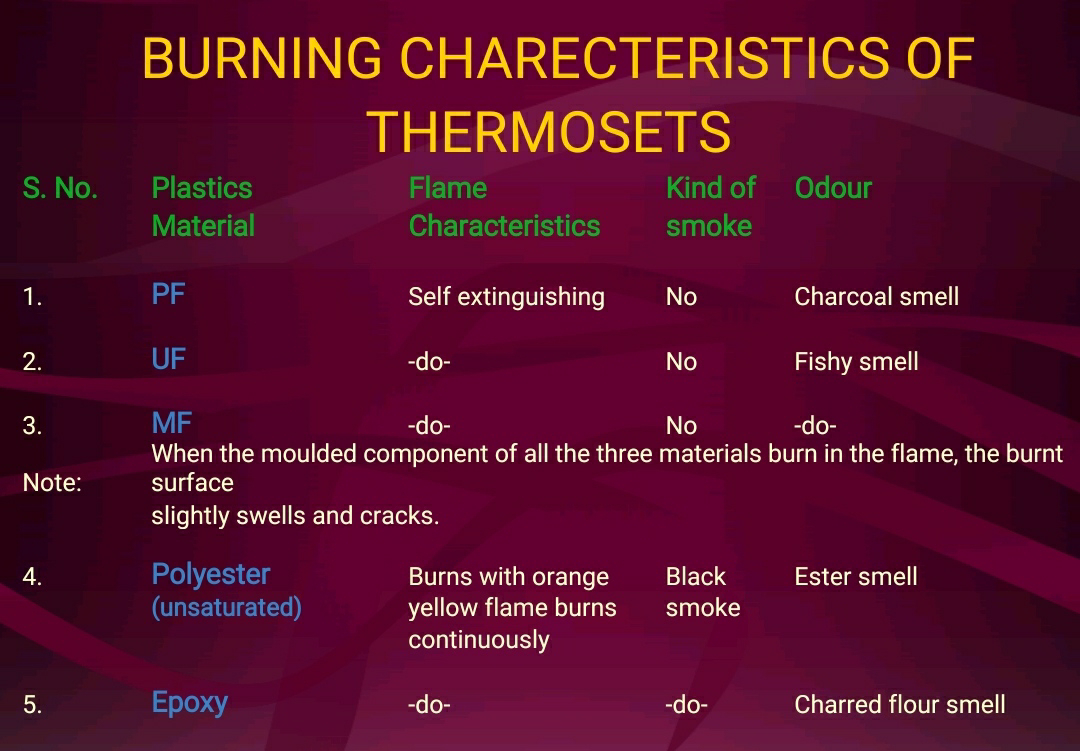IDENTIFICATION OF PLASTICS:
IDENTIFICATION TECHNIQUES
SIMPLE INSTRUMENTAL
1. APPEARANCE. 1. THERMAL ANALYZER
2. METHOD OF 2. GPC
FABRICATION
3. PENETRATION TO 3. X RAY DIFRACTIOMETER
HOT ROD AND
CUTTING WITH A 4. I. R. SPECTROSCOPY
KNIFE 5. NMR SPECTROSCOPY
4. FLOTATION TEST
5. SCRATCH RESISTANCE
6. COLOUR
7. ODOUR
8. TEAR
9. SOLUBILITY
10. BURNING CHARACTERISTICS
11. PYROLYSIS
12. MELTING POINT
13. CONFIRMATION TEST
HOW TO IDENTIFY A PLASTIC ?
Look at the sample. Is it transparent, translucent or opaque?
Feel the sample. Does it bend? Can it be scratched? What does the surface feel like?
Cut the sample with a sharp knife. Does it cut easily: Are the edge smooth or jagged? Does it crumble or flake?
Subject the sample to a float test. Does it float or sink? (the test is invalid if plastic foam. Wash with detergent solution initially to stop air bubbles adhering to surface.)
Try to burn a small piece of sample. What is the size and colour of flame? Is smoke produced? Do molten drips fall from sample and continue to burn? Is the sample self-extinguishing? Is there any odour when flame has been extinguished?
SAFETY: Use only a small sample held with tongs or pliers. Hold sample
BENDING TEST ( WITH MOULDED BAR)
PLASTICS BENDING BEHAVIOUR
1. Polyethylene - Bends, tends to remain
2. Polypropylene - Unbends most of the way
3. Polystyrene - Cracks but retains bend
4. ABS - Bend tends to remain
5. PVC (Rigid) - Bends easily and springs back quickly
6. Cellulose acetate - Bend tends to remain
7. PMMA - Cracks and splinters
8. Nylon - Difficult to bend, springs back
9. Polycarbonate - Tough to bend
THERMOPLASTICS:
VISUAL OBSERVATION TEST
Low gloss easily be scratched by nail - LDPE OR LLDPE High gloss can be scratched by nail - HDPE High gloss cannot be scratched by nail - PP
DROPPING TEST
When a moulded component is dropped on hard surface
Metallic sound Dull sound
PS, HIPS, SAN, ABS Cellulosics Polyamides
PC, PPS PPO
Polysulphone. PTFE,PMMA, Polyacetal, PVC, Polyolefins
TEST TO DIFFERENTIATE:
THERMOPLASTICS AND THERMOSETS
CUTTING TESTS
If a shaving can be pared off with knife, it may be a thermoplastic.
Note:PMMA and Polystyrene are brittle and difficult to pare
If the material is rigid and will not pare off instead flakes of powders, it may probably a thermoset plastic.
HOT ROD PENETRATION TEST
Heat an electronic soldering iron to red hot and press against the unknown sample.
a) If the plastic material softens, and the rod penetrates the sample is thermoplastic.
b) If the plastic material does not soften and the rod does not penetrate, the sample is thermoset plastic.
FLOTATION TEST
When the material is dropped in water
Floats Sinks
Polyolefins. Other than Polyolefins
Note: Filled polyolefins and cellular foams are exceptional for this test.
E.g.Sinks Floats
Talk filled PP PVC , PU
Glass filled PP and PS foams
PYROLYSIS TEST:
HEAT THE SAMPLE IN AN IGNITION TUBE AND TEST THE PYROLYTIC VAPOUR WITH A MOISTENED INDICATOR PAPER.
ACID : TURNS BLUE LITMUS TO RED
BASE : TURNS RED LITMUS TO BLUE.
ACID VAPOURS
MAY COME FROM CARBOHYDRATE POLYMERS & THEIR DERIVATIVES . [E.G., CELLULOSE ACETATE]
HIGH ACID VAPOURS
OFTEN INDICATES THE PRESENCE OF CHLORINE . [E.G., PVC OR RUBBER NEUTRAL VAPORS]
EVOLVED FROM HYDRO CARBON POLYMERS, SILICONES AND SOME POLYESTERS HYDROCHLORIDE.
ALKALINE VAPOURS
INDICATE THE PRESENCE OF N2 . E.G., POLYAMIDE, PUs, PROTEINS & AMINO FORMALDEHYDE RESINS.













No comments:
Post a Comment